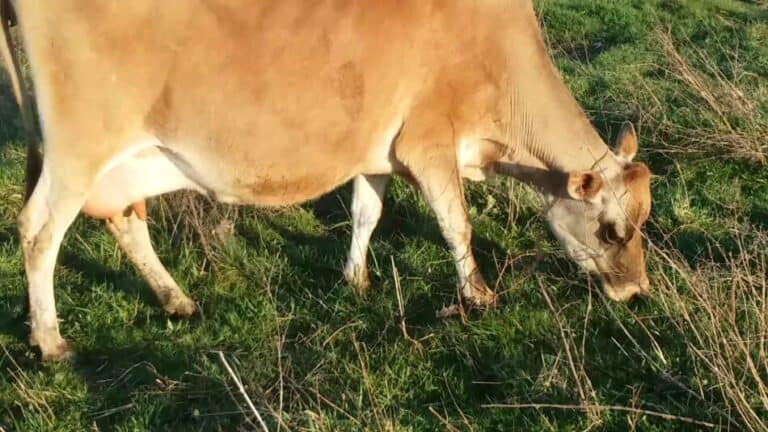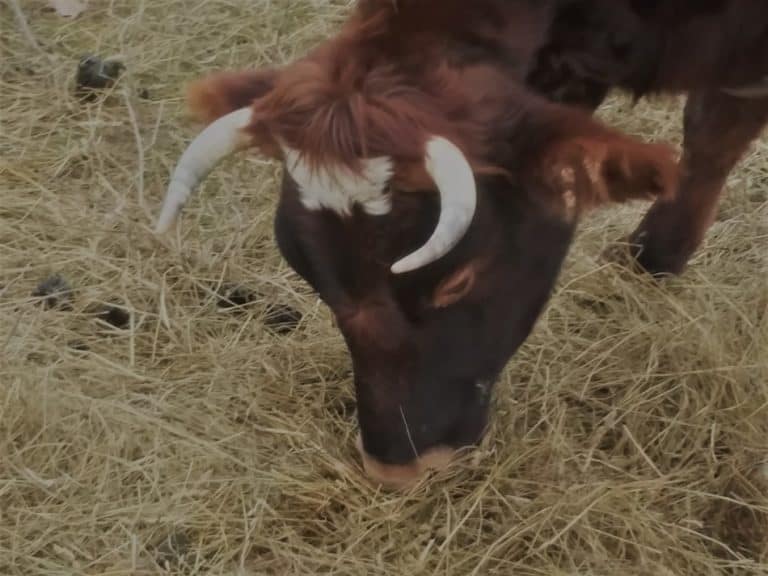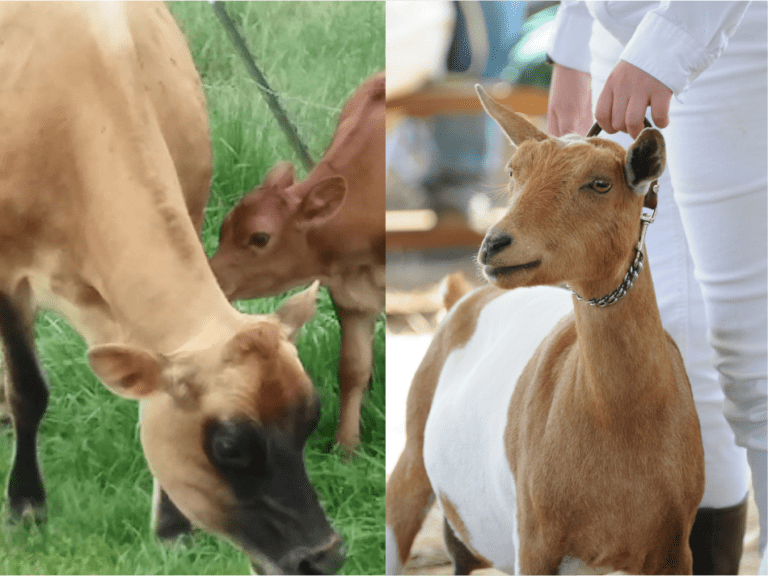Raising Bottle Calves: How To Get Started (Costs Included)
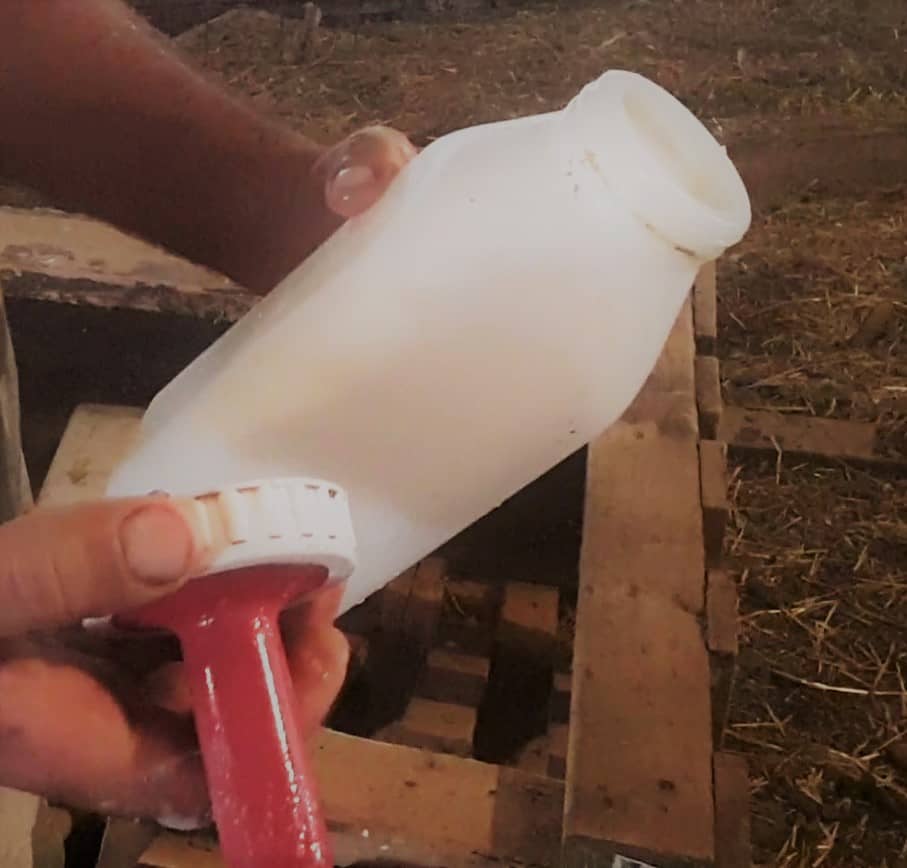
Raising bottle calves is one of the least expensive ways to get started with raising a few of your own cattle.
Bottle calves being easy to manage and kid friendly just adds to the experience!
To raise a bottle calf, you will need to buy the calf, a bottle, milk replacer, and calf feed and hay. Plan to feed two or more calves at once and feed the bottle 2 times per day, while providing free access to the hay, calf feed and water.
| Things to Buy for Bottle Calf Project | Cost |
| Calf- dairy or beef | $50-200 |
| Milk replacer | $85/bag |
| Bottle with nipple | $10 |
| Calf feed | $20/bag |
One of the things I like best about bottle calves is that they are friendly when they are little and more friendly than most cattle when they get bigger.
A calf raised on it’s mom has to be taught that people are good to have around since it gets everything it needs from it’s mom.
A bottle calf learns that people bring good things right away since we bring food.
Is Raising Your Own Beef Worth It? shows you how to compare the costs of raising your own beef versus buying well raised beef from a neighbor.
If you are new to bottle calves you’ll have some questions. Here are some of the things you’ll need to know.
Note: if you can raise two bottle calves. Cattle do not like to be by themselves. You can pen them separately as babies but they need a buddy to be happy and grow well.
You feed bottle calves for 6-8 weeks
Generally, people bottle feed calves for 6-8 weeks.
The calf would be happy to drink a bottle much longer than that, but most people would want to take a break from twice a day bottles.
For a normal bottle calf 8 weeks will be fine. If you are wanting more of a veal calf then you need to keep up with the bottle feeding for a much longer time.
Bottle calves drink 1 gallon per day
Calves drink a full two quart bottle twice a day, so they are getting a total of one gallon of milk or milk replacer per day.
Restrict the milk to one bottle, twice per day
It can be tempting to feed more than the one bottle per feeding, after all the calf would really like more right?
Yes, the calf would love more milk, but tomorrow when it starts to scour (have runny poop) you and the calf will not be happy any longer.
Scouring is the biggest problem you’ll run into with feeding bottle calves, quite often leading to death.
Seriously, scouring calves are hard to get back on track again. Please don’t fall for his begging and give him more milk.
Feed body temperature bottles of milk
The best way to avoid scours? Keep the milk at the right temperature and only feed one bottle per feeding.
The right temperature for the milk or milk replacer is body temperature. Who’s body? Yours.
Check the temperature of the milk on the inside of your wrist just like you would check the temperature of a baby bottle for an infant.
If you are feeding milk replacer, get the temperature of the water correct first then add the milk replacer powder.
If you are feeding cow’s milk, not from the store! you need to warm it up in a water bath, unless of course it just was milked from the cow!
Fill a container with warm water and stick the full bottle in the water to warm up.
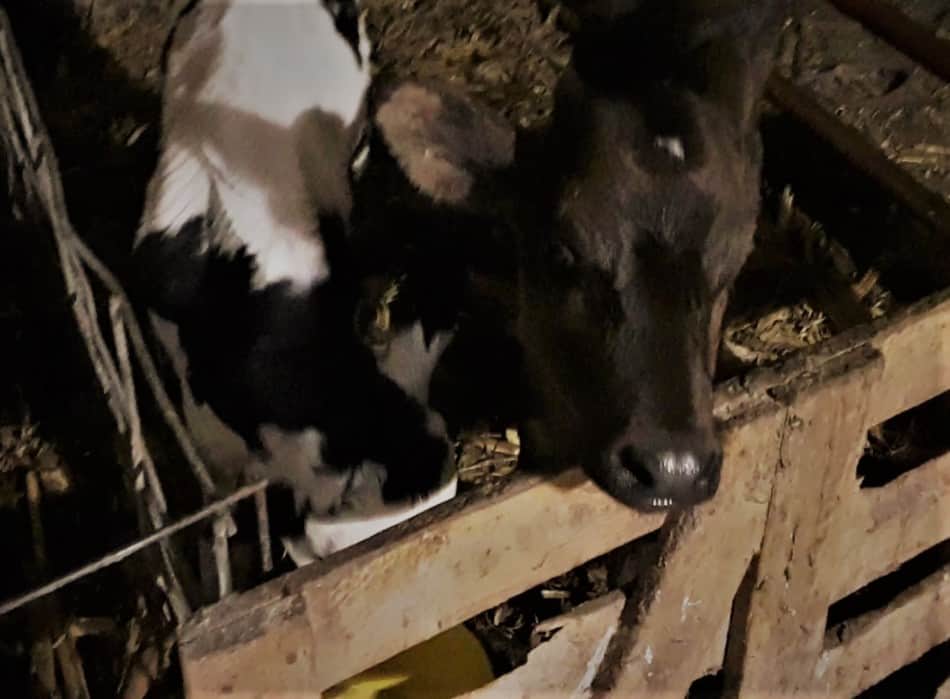
Feed milk bottle, water in a bucket
The calf needs to have water available, of course, but in a bucket to drink whenever he wants it.
The only reason I can think of to feed a calf water in his bottle is when you are trying to wean him and afraid he’s not drinking out of the water bucket.
This is actually a timing problem on your part.
If the water bucket has been in his pen this entire time, he’ll drink when he’s ready.
If you wait and put water in for him right before you want to wean him, now you’ve got issues. He needs time to learn to drink from a bucket.
Under most circumstances, only milk or milk replacer should go into the calf’s bottle.
The one exception here is if you need to give your calf an electrolyte solution, usually to help with scours, then you will need to use the bottle.
Otherwise, keep it to milk only.
Bottle Calves: 5 Survival Tips from Manna Pro gives a nice outline of your feeding options for your calves.
Calf won’t drink, have patience
The calf not wanting to drink at first is common, frustrating but common.
Especially if your calf spent any time with it’s mom, of course he would rather have his mom than you and the bottle! This is natural.
Your calf is confused and doesn’t know you have the milk he wants. Give him time to figure it out.
Just keep reminding yourself to be patient and take your time.
The best way we know of to get a calf to nurse from a bottle is to straddle the calf, like you are sitting on a horse, and pry his mouth open with your fingers and quickly stuff in the bottle.
You might even have to gently squeeze his mouth shut, then release and repeat to make some milk come out of the bottle.
While this sounds harsh, you’d be surprised at how quickly a calf will start to nurse once it realizes there is milk involved.
For most calves you will only need to grab them a few times then they will come to you for the bottle.
Once the calf knows what’s going on he’ll be thrilled to see you and the bottle show up for feeding time!
You Don’t Have To Be A Rancher! Raise Dairy Steers eat goes over the main things you’ll need to keep in mind when raising your bottle calves after weaning.
Calf was fine, but stopped wanting the bottle
If your calf has been drinking well and all of a sudden stops wanting the bottle, you have a problem. A big problem.
Even if your calf feels a bit less zippy than normal, he will still drink his bottle. He has to be really sick to not want to drink.
This is vet territory. Call sooner rather than later, timely treatment is more likely to work.
Don’t let this section scare you, bottle calves normally do well. But remember, they are babies and sometimes need a little TLC.
Be sure to castrate the bull calves
You need to have the bull calves castrated. It’s easy to do, especially if you want to use the bander.
It is a little thick green rubber band that goes around the scrotum, the sack the testicles are in, and cuts off the circulation causing it to dry up and fall off.
Putting on the band is fast and easy. Just make sure you have both testicles in the sack before you release the band off of the applicator.
The bands and the applicator (it looks like a pair of weird pliers), are easily found at any farm store. Have a friend show you how to do it.
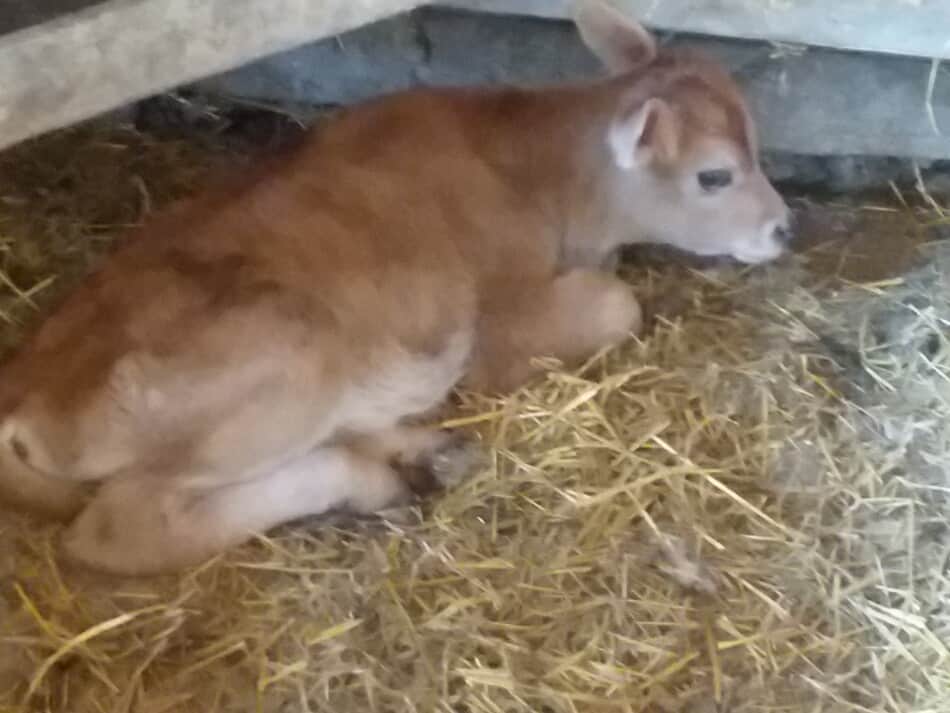
Your bottle calf does not behave like the herd
Why go to all of this trouble? A calf that is raised by people, not by his mom, never learns to behave like a herd animal.
His mom and other cows in the herd would teach him to stop being pushy and he would learn how to behave in a group.
If he got out of line, they would make him see the error of his ways, and they are big enough to do it.
Your calf has never learned to behave appropriately or to give you the space you need.
He has been raised as a spoiled only child, without discipline. When he gets older and his hormone tell him to start testing you, he wins.
You will stop the majority of this potentially harmful behavior by cutting out the source of the problems with castration.
I don’t write this to scare you. Once castrated, he will be level headed (as much as his genetics allow) as he gets bigger.
Steers (castrated bulls) are actually easier to manage than heifers (female calves), bulls are not. Castrate the calf.
Calf poop should have shape
As long as the calf is getting a bottle the poop will have more of a yellow or orange look to it, but the important part to notice is not color, it’s consistency.
No matter how much milk the calf is getting the poop should have a tube shape.
Runny calf poop needs monitoring
Runny poop, like a smoothie, means he’s getting too much milk and is having digestive problems.
Cut back his milk, make sure he has clean water and a clean pen.
You must monitor this closely, If he gets better in a day or two, no worries.
If the poop continues to get more runny, get some electrolytes and some knowledgeable help.
A calf with super runny poop needs the vet
Super runny, like brown water, means your calf has a serious digestive imbalance that will shortly cause dehydration.
Dehydration is a biggie, since it gets out of control fast and is the biggest cause of bottle calf death.
You need to call the vet. Don’t wait until after work, call now. Quick treatment gives the best chance of recovery.
Bottle calves need a pen and bucket
Anything else you would need for the calf you probably already have, like buckets, a pen to put him in and bedding for the pen.
None of this stuff needs to be specially purchased, the calves will do fine using normal items.
If you don’t have a shorter bucket, consider getting one. Heaving around a 5 gallon bucket gets hard, but nothing wrong with doing it.
I like the buckets with the flat back so they hang or fit better on the edge of the pen, but that’s only if you don’t have a suitable bucket at home already.
Do not keep the calf as a breeding animal
While keeping the calf is tempting, after all you did just put a lot of time and care into this calf, it’s a bad idea.
I’ve even seen a well known magazine article recommending keeping bottle calves as future breeding stock, but I’ll repeat: this is a poor decision.
Don’t keep bottle babies as adult cattle!
Let’s talk about it. Think about all of the things you want your future cattle herd to do for you.
I want cattle to be healthy, able to reproduce reliably-including give birth on her own and grow well. If you have different priorities then list them out.
What is the likelihood that these bottle calves will perform the way you want your future cattle to perform? Remember genetics are a big factor in results.
If you keep these bottle babies and raise them to be the start of your herd (you would be breeding them and hoping that they will raise babies), these calves will be the genetic foundation of your stock.
If your calf was taken from his or her mom because of problems, keeping that calf is perpetuating those problems.
Bottle baby dairy heifers is normal
If you are starting a dairy herd, then this is the normal way most heifers are raised. No worries here.
Good genetics or bad, dairy calves are raised on the bottle.
Do not keep beef bottle babies
Beef calves are a different story, since they are not usually available as bottle calves.
If you have a beef calf for a bottle baby, lucky you, they are hard to find. That will be great beef for your freezer.
What, not keep her as breeding stock? No, please don’t.
There are not any good reasons for a beef breed heifer to be a bottle baby, only bad reasons, like the mom died or at best can’t take care of her.
When this heifer grows up she will have the traits of her parents, including whatever troubles caused her to be separated from her mom.
This is doubly true for a bull calf. Like it or not a bull is 50% of the genetics of your herd.
You will be passing on his genetic problems by keeping him. Don’t do it! Castrate him and put him in the freezer.
How much will it cost to butcher your grown bottle calf? Read Cost To Butcher Your Own Beef.
Get your bottle calf at the farm
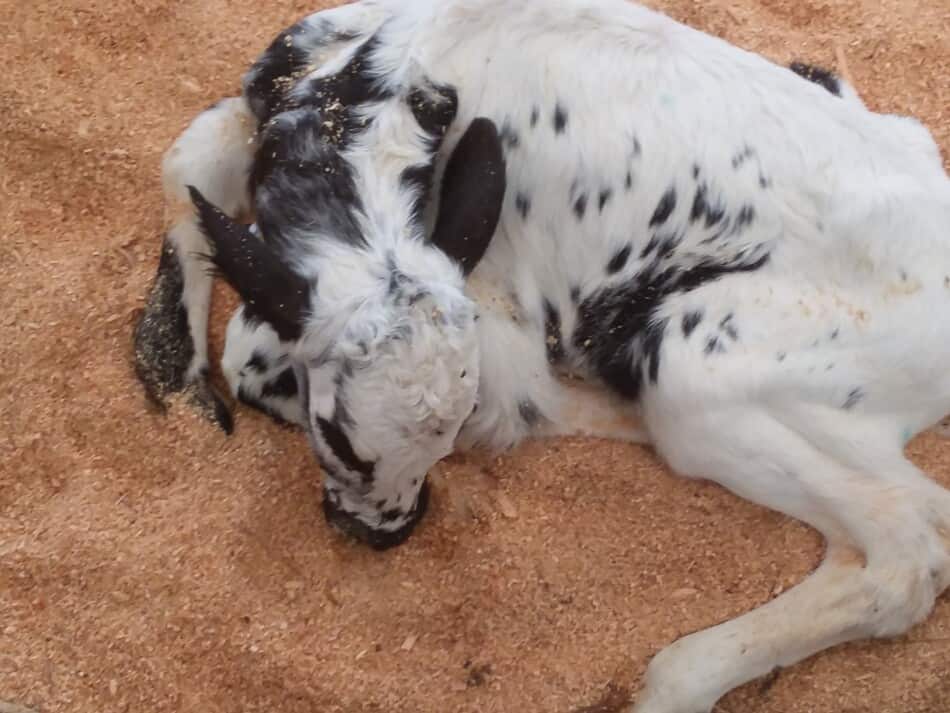
If at all possible, get the calf directly from a farm. The calf will have the best start in life with as little stress as possible.
Ask around or put an ad online. Go pick up the calf as soon as they call.
Don’t try to bargain down the price. Pay cash and be easy to deal with. It’s worth your time and money to start with a healthy calf.
A sale barn calf has had a rough day.
A day at the sale barn includes trucking both ways and being moved around the unfamiliar pens, along with a bunch of other calves in the same situation. This is very stressful.
If there are any communicable diseases present, a sale barn calf was exposed to them while in at a weak point in his immunity. Not good.
Ideally, the calf will have had colostrum from his mom. Colostrum is the first milk that is produced after a baby is born.
The colostrum is the foundation of the calf’s immune system.
It helps set up his immunity for the first few weeks until his own immune system is up and running.
It’s worth the extra money to pay for a calf that was given colostrum.


